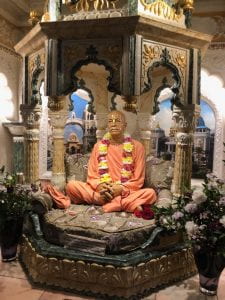Visiting the ISKCON Temple in London last week was such unique experience. I was struck by how plain the temple was on the outside, how it just looked like any other store front in the London SoHo area, even though what was inside was the opposite of mundane. ISKCON, or International Society of Krishna Consciousness, was brought to the United States in 1966 by Swami Prabhupada, who subsequently spread it all across the world, including to London. It has grown out of the Hare Krishna movement, which was founded in Bengal in the 16th century.
The Hare Krishna moment is, as evident in its naming, designed around worship to the Hindu diety Krishna, the supreme God, making the movement a strain of Hinduism. It differs from other forms, however, in that their worships are based solely in chants and mantras, their most famous one being a repetition of Krishnas name eight times.
We were able to sit in on a temple worship, and fully immerse ourselves in their service. The service itself was rather short, and compared to the long and oftentimes monotonous Christian church services I have attended, it was vibrant and interactive. Rather than speaking at parishioners, the service was based on uplifting chants and dances, with everyone free to sing and dance at their leisure. Because chanting is such an integral part of Krishna Consciousness, it was not surprising that the entirety of the service was filled with song. We even heard the chants on the street before the service when we were learning about the history of ISKCON.
Aside from the chanting, one of the things that struck me most during the service was the absence of women preforming important roles. The mantra leaders were men, the person who poured the water on us and performed the rituals was a man, and the person who sent us off at the end was a man. I noticed that there were many women in the temple, performing various administrative duties or just helping out, so it stuck out to me that none of them had leading roles in the service. This lead me to the question: what is the role of women in the Hare Krishna moment?
According to historian Thomas Hopkin’s essay ISKCON’s Search for Self-Identity, that question has tripped up the Hare Krishna’s since the death of Swami Prabhupada in 1977. After his death, the Hare Krishna movement in the United States lost traction, and there was tension and discord between many of the young gurus, who didn’t fully understand the impact of their roles. In these times, the gurus treated women with contempt, and as such women were marginalized by the Hare Krishna’s for years. Hopkins notes that the death of Swami Prabhupada caused many young men to become gurus before they had lived a full life, with a wife and kids, forcing them to skip that section of life. This lead to a lot of them feeling threatened by sexual matters and female sexuality.
Today, the Hare Krishna’s are trying to move past and learn from their history of marginalization of women, and focus on their devotion to Krishna and the core values of Krishna Consciousness. However, I could still see the remnants of the affect the death of Swami Prabhupada had on the movement in the service, meaning that though it may be better than it was in the early 1980s, they still have a ways to go before there is true equality within the movement.


